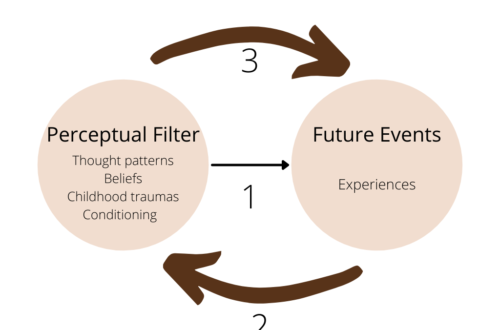How to set goals in life and achieve them using 4 simple steps
Have you tried to set goals before or stick to new year’s resolutions? How did it go? Were you able to achieve them or did you forget about them throughout the year? Regardless of your past history check out this comprehensive guide on how to set goals in life and achieve them!
When it comes to goal setting, there is so much information out there and it can get overwhelming to know what to do and what not to do. Often this overwhelm can be one of the reasons we don’t take the time to set proper goals.
Another issue that people struggle with is not achieving their goals or perhaps feeling dissatisfied even when they do achieve them. If you’re an ambitious overachiever, this guide is especially for you. You will learn to keep your goals organized and create an easy system to achieve them so that you can effortlessly achieve your goals.
A scientifically proven step-by-step method to set goals in life
Firstly, let’s define what a goal is. A goal is generally an outcome you are expecting to receive and hoping to work towards. For example, a goal could be to reduce 10 pounds, write a book, get straight As and so forth. The important thing to note is that a goal is generally outcome focused.
1. Set an intention or theme for the year (optional)
Now how does one actually set goals? Before you begin to write down your goals, try to set an overall intention or theme for the year. What do you want to focus on? It can be vague or specific. Your focus of the year could be to nourish yourself or step into alignment with who you really are. Whatever it may be, decide where you want to pour your energy this year. Now keep in mind, this is different from a goal as it’s more intention based. This step is optional and if you don’t find it to be useful, you can skip it.
2. Find a tool to write your goals
Now we are ready to start setting goals. You can try to keep goals in your head but that’s not always efficient. It’s best to write down your goals to create clarity and keep a system in place. How you write your goals down also matters.
To keep things organized, it helps to choose a tool that you use on a regular basis to set your goals. You can use a journal if you check it every day or your laptop! I like to use Notion as I can set up a separate page for my goals and track them more organized manner.
Again there is no rule here, do what you like but the idea is to write your goals down in a place where you will see them regularly so you don’t forget about them after a month. This is why keeping goals in your head is not the best idea. You’re less likely to remember it as different situations require your attention. If you’re a visual person, it may help to create a vision board and keep it in a place where you can see it every day.

3. Choose goals that you value.
Set goals in life that are in alignment with your theme or intention for the year. This is optional however as you may have other things you want to accomplish. One thing I like to do is set goals for each area of my life. There are multiple areas of our life: career, financial, mental, emotional, spiritual, health or physical, relationships, and any other you can think of. You can set goals for one of these areas, some of them or all of them. However, the important thing to note when you set goals is to choose self-concordant goals.
Self-concordant goals are goals that are based on your authentic interests and values. When you choose goals that you value, you are more likely to put in the effort to achieve them, therefore, making it more likely that you’ll achieve them. Moreover, science shows that by achieving self-concordant goals, you’re likely to satisfy your needs and increase your well-being (Sheldon & Elliot, 1999).
So pick goals that you value and write down what you want to achieve. You can make it as specific as you like or keep it a bit vague but still clear. For example, if you want to grow your social media following, you can write “get 10000 followers” or “grow social media following”. The latter holds more possibilities but you choose what works for you.
4. Write your why.
The final step to goal setting is to write down a why beside each goal. If you have a why you will have a stronger reason for achieving your goal and you will be more likely to achieve it. Check out this Ted talk by Simon Sinek to understand the importance of why. Anytime you feel demotivated, looking at your why will remind you why you have that goal.
Make your why something deeper than your goal and make sure it is meaningful to you. For example, your why for losing 10 pounds may be to feel better about your body and health. Your why for making 10K a month may be to pay for the expenses of a sick loved one or to pay off debt and live a more financially abundant life. Most importantly choose a why that elicits a strong emotional response within you.
How to create a system to implement your goals and achieve them
Often, we set goals, write them down, and take action a few times. Then we forget about it. We forget that we have to take consistent action. But how do we find the motivation to take consistent action? Have you noticed that after a while of seeing no results in the gym, all we want to do is give up?
Well here’s the solution to motivation: consistency. Doesn’t sound too great but the reality is motivation is a fleeting feeling. You sometimes feel it and others times you don’t. Regardless of how we feel, the only way to reach our goals is through consistent action. This means going to the gym when you don’t feel like it or studying for the test even when you don’t want to. But in order to take consistent actions, we need to make our lives as easy as possible so that doing the actions that take us to our goals is as easy as possible. This means creating a system.
What is a system and how do you create one?
A system is a process that makes taking action easier. It is organized, logical, and it flows. For example, your system for going to the gym may be to leave your gym clothes out in the morning so as soon as you see them, you are ready to put them on and go to the gym. If you need to study for a test, you may first open your laptop and read the class material, then practice questions, and review with a tutor.
A system is specific to the goal but it helps to achieve the goal with more ease. Check out the tips below to help create easy systems for your goals.
1. Break down the big goals into small goals.
Since these are yearly goals and your time frame is a year, break the big yearly goal into monthly goals. Write down all the things you would need to do each month to get to your goal.
Then break each of those monthly goals into weekly goals to determine what you need to do each week to reach your monthly goals.
On a daily basis, take the smallest step or action to achieve your weekly goals.
Over time, this reduces overwhelm and increases momentum for you to reach your goals. For example, if your goal is to write a fiction book in one year, break it down into monthly goals such as writing one chapter each month. Then break that into weekly goals such as setting the plot, writing character descriptions etc. On a daily basis, this may look like writing a few paragraphs. The important thing is to take some sort of action every day that brings you closer to your goals.
2. Experiment, Experiment, Experiment
Some systems may not work so you may have to try something else. For example, if leaving your gym clothes out doesn’t work, find an accountability buddy. Sometimes you may realize it is not the system. Rather you may not have been clear about the goal. Regardless, if one thing doesn’t work, try something else.
3. Try to pair your goal activity with something you already do.
James Clear talks about the idea of habit stacking in his book Atomic Habits. The idea is to do the habit you’re trying to implement before or after you do something on a daily basis. For example, if you’re trying to meditate daily and you shower daily, you can meditate right after showering. You can even set implementation intentions such as I will do X before/after I do Y. This way your brain will pair the two activities together and over time, it will become a habit. For example, you could choose to go to the gym after you wake up and before you take a shower.
4. Keep your list of goals in a place you look at daily.
If you write your goals and never look at them again, you won’t achieve them because you’ll forget about them. Once you set goals, put this list in a place that you’ll see daily. Some ideas could be to set it as your desktop wallpaper or create a vision board. Make sure to write your systems and keep that in a visible place in case you need to refer to them. This simple hack will increase the odds of you taking action on your goals thus making it more likely that you’ll achieve them.
5. Do weekly and monthly reflections.
This is important so that you can track your progress and see how far you’ve come. Take a moment to celebrate those small wins! It matters. Reflections will also help you see if the system for reaching your goal is working or not and if it isn’t, it’ll give you a chance to think about how you can change that.
6. Focus on one goal at a time
This is important as focusing on too many things at a time can be overwhelming and reduce focus. Eliminate to focus. There are also multiple studies that show the negative effects of multitasking on performance. Sometimes you may be able to focus on two goals if they’re from different categories but still align with each other. For example, you may want to work on having a fit body and attracting the partner of your dreams. These goals don’t clash with each other and focusing on one won’t deplete energy from the other. However, where possible, try to focus on one goal at a time.
Once you’ve achieved one goal, focus on the next one.
How to measure your goals
Measure your goals by how consistently you show up for them. Not whether or not you achieve them. For example, if your goal is to lose 10 pounds, don’t go to the gym every day and see if you lost weight every day. That most likely will demotivate you to stop going to the gym altogether. Focus on how consistently you show up for yourself. Did you choose a low-carb meal today? Did you workout 3x a week this week?
For goals that have obvious metrics or a way to measure your progress, feel free to use those metrics but also focus on the growth and not just the outcome. For example, if your goal is to ace all your courses, grades are the perfect metric to track whether you achieved them. But if you aced half of them, focus on that progress rather than the disappointment that you didn’t ace all of your courses. Focus on the skills you gained or anything else that you learned. If you learned anything despite not reaching the goal, that’s progress. Then keep persisting!
Eventually, you will attain the outcome but being focused on the outcomes initially is not the best way to track your progress. Additionally, by showing up for yourself, you are creating a new identity for yourself. This will also help you to reach your goals faster. When you reach your goals, set even bigger and bolder goals!
Summary
Now that was a lot. To make your reading easier, let me summarize how to set goals in life and achieve them.
There are four steps to setting goals:
- Set an intention or theme (optional).
- Use a journal or online tool to write your goals and track them.
- Choose goals that you value and are inspired to work on.
- Write why you want to achieve your goals. What’s the driving emotion?
Create a system to achieve goals faster and with more ease.
- Break the yearly goals into monthly, weekly, and daily goals.
- Experiment with the system, and change up your strategies as needed.
- Pair your new goals with something you already do to create a learned association in your brain.
- Keep your list of goals in a place that you look at daily so you can be reminded of your goals every day.
- Do weekly and monthly reflections to track your progress and change your strategies.
- Focus on one goal at a time to avoid distractions.
Have fun in the process and enjoy!
References
Sheldon, K. M., & Elliot, A. J., (1999). Goal striving, need satisfaction, and longitudinal well-being: The self-concordance model. Journal of Personality and Social Psychology., 76, 482-497.


2 Comments
Andreas
I appreciate your approach of writing. Your website is well-written and engaging.
Guneet
This is a great guide. For me, I think #2 & #6 are the most important parts of the system. They help me with consistency!